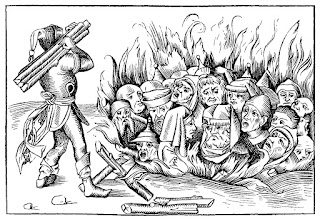Prague - Easter Massacre of 1389
18 April, 1389
The Day After Passover and Easter
Prague, Holy Roman Empire
The Day After Passover and Easter
Prague, Holy Roman Empire
Angry over a supposed incident in which some Jews knocked over Eucharist wafers, a mob of Christians stormed the Jewish Quarter of Prague with stones, swords, axes and torches, eager to take revenge. As the residential buildings burned, the Jews ran to the stone Altneuschul for safety. The mob pursued them, storming the synagogue and putting those inside to the sword. Ultimately, around 500 Jews were killed in the entire incident, though the more commonly cited figure is 3,000. It is unknown how many were slayed inside the synagogue. (Barbara Newman, The Passion of the Jews of Prague).
This event lived on in the collective memory of the Jewish people in at least two ways. Firstly, for centuries afterward, visitors to the Altneuschul were shown interior walls that were supposedly stained with the blood of the martyrs. Even after the synagogue was renovated in 1618 and the walls repainted, the story continues to be retold. (Carol Herselle Krinsky, Synagogues of Europe: Architecture, History, Meaning, 170)
Secondly, as with many similar events, the violent attack was commemorated through liturgy. Rabbi Avigdor Kara composed a slicha which for centuries was recited as part of the Yom Kippur prayers in Prague. He wrote: "They broke into the Altneuschul...our young and old were attacked with swords...and their corpses fell to the ground." (Siddur Slichot Mikol Hashana, #145)
The spirit of Kara's slicha fits in the tradition of Martyrdom Poetry which was popular in the previous centuries and is heavily influenced by similar descriptions of the massacres of 1096 (which I will address in a later post). Subsequent uses of the imagery of synagogue massacres reinforced its place in the Jewish subconscious. (Evina Steinova, All that Suffering: Hebrew Narratives about the Prague Easter Massacre of 1389 and their Interaction with the Latin Material.)
This event lived on in the collective memory of the Jewish people in at least two ways. Firstly, for centuries afterward, visitors to the Altneuschul were shown interior walls that were supposedly stained with the blood of the martyrs. Even after the synagogue was renovated in 1618 and the walls repainted, the story continues to be retold. (Carol Herselle Krinsky, Synagogues of Europe: Architecture, History, Meaning, 170)
Secondly, as with many similar events, the violent attack was commemorated through liturgy. Rabbi Avigdor Kara composed a slicha which for centuries was recited as part of the Yom Kippur prayers in Prague. He wrote: "They broke into the Altneuschul...our young and old were attacked with swords...and their corpses fell to the ground." (Siddur Slichot Mikol Hashana, #145)
The spirit of Kara's slicha fits in the tradition of Martyrdom Poetry which was popular in the previous centuries and is heavily influenced by similar descriptions of the massacres of 1096 (which I will address in a later post). Subsequent uses of the imagery of synagogue massacres reinforced its place in the Jewish subconscious. (Evina Steinova, All that Suffering: Hebrew Narratives about the Prague Easter Massacre of 1389 and their Interaction with the Latin Material.)



Comments
Post a Comment